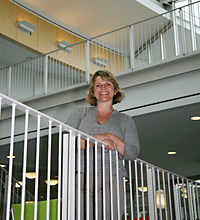Campus Center Now the
Heart of Smith, Survey Says

Photo by Judith Roberge |
| |
The Campus Center has become the single most popular
spot for Smith students to meet their friends, grab a snack, find a quiet space and
show off to visiting friends and family, says a new survey by a School for Social
Work student.
Stephanie Keep, a master’s of social work candidate
and a Smith ’02 graduate in psychology, gauged student perceptions of the Smith
campus both before and after the 2003 opening of the center, which houses a café,
post office, student mailboxes, campus bookstore, lounge space, art gallery, pub,
meeting space and offices.
The most significant change between the first survey
responses in 2002 and the second, in 2005, was the students’ wholesale shift
of activities from a variety of campus locations to the single structure.
“The Campus Center had become a social hub for
informal and formal socializing, an emblem of campus pride, and a meeting place outside
of dorms,” said Keep of the feedback she received from nearly 500 students.
Keep mapped her findings using Geographic Information
Services (GIS) technology for her 2007 master’s thesis, which she will present
during a School for Social Work poster session on Monday, July 23, from 7 to 8:30
p.m. in the Atrium of the Smith College Museum of Art.
Before the 56,000-square-foot
building opened, students in Keep’s survey specified
a variety of campus spots for hanging out with friends or finding a quiet space.
After the facility’s opening, they said the Campus Center served both of those
purposes and more.
In the earlier survey, students noted that the former
student center, the Davis Center, was where they went for a snack outside of their
residences, and where they typically hung out with friends. Afterward, the Campus
Center replaced Davis Center as the preferred spot for those pastimes.
Between the first and second surveys, Keep also found
a change in the number of students who believed there were places on campus they
could “hang out” – about twice as many after the Campus Center
as before.
In 2002, students said the areas or buildings they showed
most to visiting friends and family were the Tea Hut, Boat House, Lyman Plant House
and gardens, Science Quad green and Seelye Hall. By 2005, that list had shifted nearly
entirely to the Campus Center and Museum of Art, which was also under renovation
in 2002.
The survey offered one surprise, according to Keep.
After the Campus Center was built, students indicated slightly less interaction with
faculty than before it was built.
“I thought that was interesting because I always
see faculty when I am in the Campus Center,” she said.
Keep undertook this research as a way to assess subjective
information. “We can get caught up in facts as if that is how we feel, but
how we feel is a different thing. I wanted to try to find a quantitative
way to show qualitative info.”
Social workers, program planners, project managers
and policy makers should factor in the perspective of clients when planning and implementing
change, she said. “The
building of the Campus Center was a change effort, designed with a mission to bring
together the Smith College community, which successfully met its primary goal.” |























